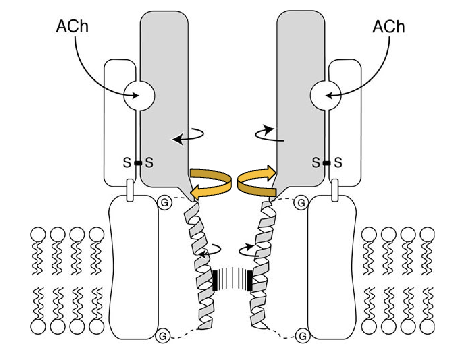Biomed 2 - Cell communication0
1/48
There's no tags or description
Looks like no tags are added yet.
Name | Mastery | Learn | Test | Matching | Spaced |
|---|
No study sessions yet.
49 Terms
What are membranes
Physical barriers impermeable to all things and substances
create different physical compartments between cells
What are the ways that cells signal
Intracellular signalling - between cellular compartments
Intercellular signalling - From cell to cell
Signalling from 1 to multiple cells - can be sent via blood/synapses
What are gap junctions
Cells communicate via gap junctions
Small gaps which allow small molecules to pass through 2 plasma membranes
How do signals cross membranes
Hydrophobically - free diffusion of gasses
hydrophilic - pumps, channels, vesicles, signalling molecules
How do signals cross membranes hydrophillically
Via pumps, which sit on the membrane and transport hydrophilic molecules to the other side of the membrane
Ion channels which allow ions/metals to pass at specific times
Vesicle fusion
Indirect signalling through receptors/pathways
How are signals released?
Constitutively - a cycle, flowing down the concentration gradient
Evoked - Only when a cell needs to evoke a signal - Gated channels open at specific times
What is free diffusion
Gases diffuse freely across the membrane - must be tightly controlled however gases are short lived
Ex of signalling molecules for it are steroids and gases
What is exocytosis and endocytosis
Endo - Molecules are digested by the membrane and brought into the cell
Exo - Signals packed into intracellular vesicles and released constitutively or evoked outside the plasma membrane
Ex. Proteins, peptides, amino acids, nucleotides
Examples of signalling molecules
Proteins, peptides, amino acids, nucleotides
What are the forms of signalling from secreted molecules
Paracrine, autocrine, synaptic, endocrine, gaseous signalling
What is paracrine signalling
Signal only affect cells in the immediate cellular environment
Very localised and limited to unicellular organisms
No diversity of signals due to receptor and signal being close in proximity
Terminate the signal by uptake into neighbouring cells, destruction by enzymes, sequestration by the extracellular matrix
What is autocrine signalling
Signal is released to the exact same type of cell = produces a higher concentration of signal compared to the single cell - boosts the signal, limited scope
What is synaptic signalling
Neurones are used to control complex multicellular organisms
What happens in neurons to activate action potentials
Information travels unidirectionally:
received in the dendrite » transduced along axon » transmitted to next neuron in the nerve terminals
Active dendrite = action potentials along the axon which reaches nerve terminals which secretes a neurotransmitters » transduces signal to another neuron
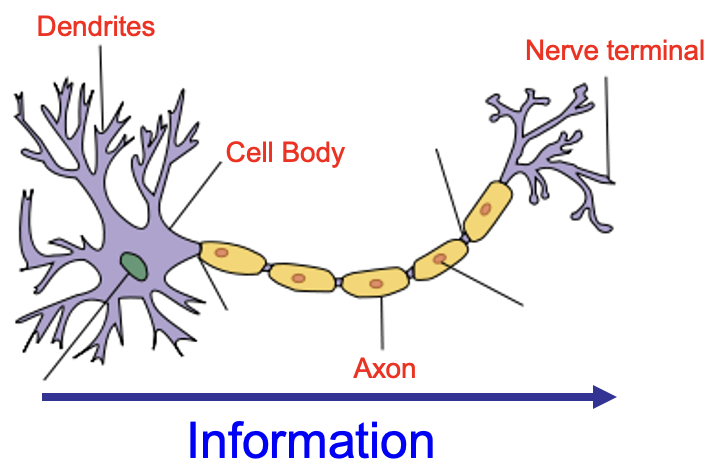
What are synaptic junctions
Ensure the signal is transmitted specifically and quickly

What is endocrine signalling
Secrete hormones into the blood
Specific - flows all around the body but only binds to its receptor
Huge diversity of signals/receptors
What is gaseous signalling
Released gases bypass the plasma membrane and directly activate enzymes inside the cell
Endocrine vs synaptic signalling
| Synaptic Signalling | Endocrine Signalling |
Distance | The target is 100nm away from the release of the signal - short distance | Targets anywhere in the body - long distance |
Speed | Fast - take little time to reach the target | Slow - relies on diffusion to reach the target |
Affinity of target | Low affinity receptors - signals are highly concentrated at the synapse | High affinity receptors - signals get diluted in the bloodstream so need high affinity receptors |
What type of cells don’t need receptors
cells which use signalling via gap junctions or gases
What are receptors
Transmembrane protein located on surfaces of cells
Binding of the signal activates the receptor = production of intracellular signals
What are Ionotropic receptors
Allows for the flow of ions across membran
Opening of receptor allows passage of ions down gradient = changes membrane potential
Very selective
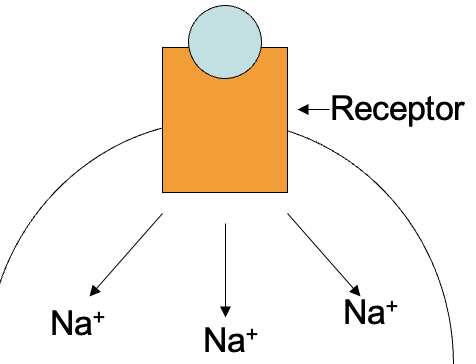
What are excitatory ionotropic receptors
High concentration of positive ions in the cell - depolarises the cell
Inhibitory ionotropic receptors
High concentration of negative ions in the cell - hyperpolarises the cells
What are metabotropic receptors
Generate new signals inside the cell (2nd messengers)
Indirectly regulate membrane bound proteins - signal doesn’t cross the membrane
Crosses through trimeric G proteins
What are trimeric G proteins
Intermediate between the receptor and target
has Alpha, beta, gamma subunit
Ligand binding = activates alpha subunit which binds to GTP = dissociation of B and G subunits which alter the activity of ion channels
This repeats in a constant loop
Baseline of metabotropic receptors
Neurotransmitter binds to its receptor » G-protein binds to receptor » activates enzyme » 2nd messenger activates > cascade » modifies ion channels
What are kinase receptors
Modify existing molecules to generate new signals
Usually enzymes/associated with enzymes
Ligand binds outside the cell = the kinase receptor amplifies signal inside the cell
What happens in kinase receptor pathways?
Ligand binds to kinase receptor » kinase phosphorylates itself by binding a Pi group which alters conformation of kinase to create a binding site to attract more Pi groups » further phosphorylation cascade of all enzymes
What are steroid receptors?
They’re located inside the cell to change gene expression by transcription
Activates transcription for gene expression, but attaches to the genes to create a protein = changed function
How to activate steroid receptors
Bind to DNA in the nucleus (before ligand binding) /cytoplasm (after)
Creates 2 responses:
A quick, small primary response
a slow, massive response
How fast are the receptors
Type | Description |
Ionotropic | Very fast due to the high concentration gradient of ions on one side of the membrane + low concentration of ions on the other |
Metabotropic | Relatively fast - speed is limited by the number of enzymatic reactions in the cell. |
Kinase | Relatively fast - speed is limited by the many reactions it causes. |
Steroid | Quite slow due to both primary and secondary responses. fast are the recep |
The same signal can have multiple receptors…
1 signal can have multiple diverse effects - meaning the location of the receptor is important to the response
Even those int he same location can have different responses
Agonists vs antagonists
Agonists bind to the receptor directly > activates the signal to mimic the signal that the ligand would make
Antagonists bind to receptor indirectly or directly to block the signal/response of the ligand >> inhibits function of the receptors
Direct vs allosteric antagonism
Allosteric - binding at different site » conformational change so ligand cannot bind
Why is it important to know the structure of a drug?
Subtle changes to structure = change in function
What is a drug
it must produce a biological effect when given to a living organism
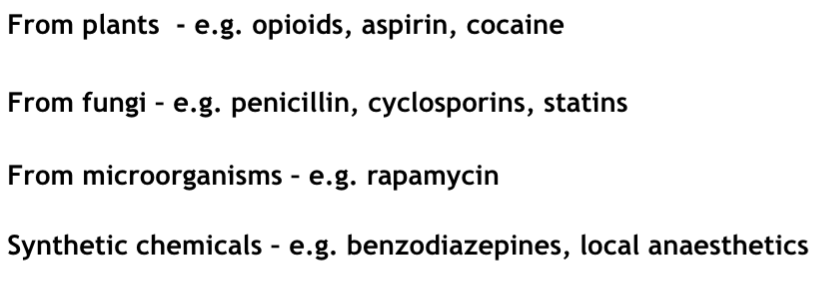
What is a medicine
A chemical preparation containing 1 or more drugs + other components (stabilisers, solvents)
What are biopharmaceuticals?
A wide range of medicinal products created by biological processes - usually involves recombinant DNA technology
Ex. vaccines, humanised monoclonal antibodies, hormones
Selectivity of drug action
Drug targets are extremely specific
Must have a selective action on a tissue
reflects specific expression patterns of protein drug targets
GOAL = low conc of the drug has high specificity to bind to the drug target (too much concentration = drug will bind to another receptor = bad)
What are the targets for drug action and where are they found?
Receptors, ion channels, enzymes, carrier molecules
They are found anchored in the cell membrane of cells
What decides the ability of drugs to work
Their ability to cross the cell membrane to get to targets within cells
What are receptors?
Proteins whose function is to recognise and response to chemical signals
Any target molecule with which a drug has to combine in order to elicit its specific side effect
What are ligands
Any drug that binds with high specificity to a molecular protein target
Ka = dissociation constant/association constant - equilibrium constant for the ligand
Kd = general equilibrium constant for the drug
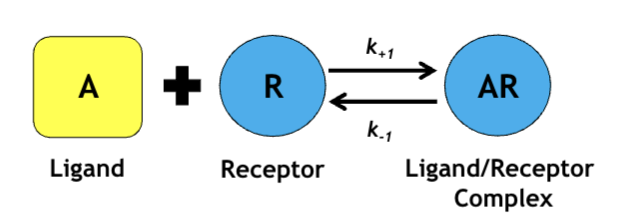
What is Ka
The dissociation/association constant
What is Kd
A general equilibrium constant
smaller Kd means the drug binds with higher affinity
How do you get rid of agonist occupancy
Addition of an antagonist
Then increase agonist concentration to restore occupancy
What is an allosteric modulator
Positive - increased affinity for antagonist to bind/agonist to activate the receptor
Negative - binding will reduce the agonis’ts signal/efficacy
What happens when Ach (agonist) binds
Rotation of the outer subunit structure = opens channels
